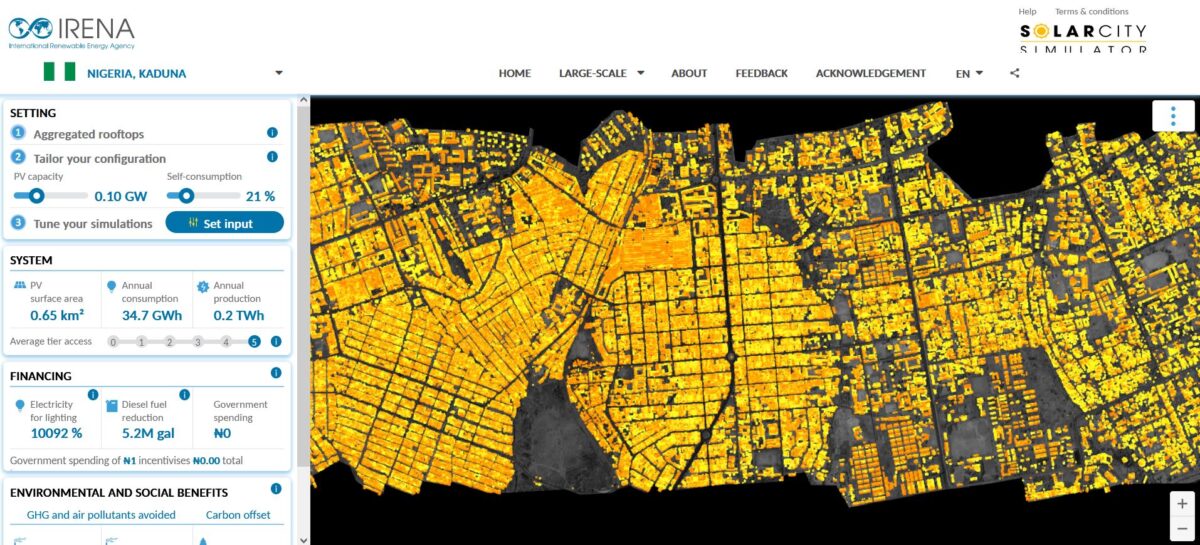The International Renewable Energy Agency (IRENA) explains how to optimally use its SolarCity Simulator, an open-access platform designed to help member countries to deploy PV systems at the municipal level.

Cities face increased energy supply challenges ranging from aging infrastructure and high consumer tariffs to efficiency and reliability issues. At the same time, growing energy demands are driving cities to seek more sustainable, reliable, and affordable energy solutions. With the declining costs of solar photovoltaics and advances in technology, more cities are turning to rooftop solar in their urban energy planning.
Supporting cities in their energy planning process, IRENA has developed a user-friendly web application called the SolarCity Simulator. The online tool allows municipal authorities to assess their solar energy potential, while addressing the issues of affordability and environmental externalities.
As part of the Global Atlas for Renewable Energy Initiative – the largest ever such open source initiative incorporating renewable energy resource maps, datasets, and supplementary information – the SolarCity Simulator was developed in close collaboration with countries authorities. It examines a city’s 3D building footprint obtained from satellite imagery and the solar resource profile.
The user-friendly simulator allows households, businesses, and municipalities in selected cities to evaluate the costs and benefits of installing rooftop solar PV in their chosen location. By simply selecting the city on the map, the scale, the particular roof and configuration of the PV system to install, users can immediately see:
(i) The technical potential for each selected roof, including mapping of the suitable areas to install PV systems at 1m2 spatial resolution with its corresponding electricity production at different scales (hourly, daily, and annual).
(ii) The financial potential of different case studies (homeowner, investor, and government) considering a range of economic indicators, such as payback, Equity Internal Rate of Return, and investment cash flow, considering the local context of the cities.
(iii) The Socio-environmental benefits through information on the annual carbon emission avoided, the equivalent number of tropical trees planted, the equivalent number of cars taken off the street when sourcing the electricity from rooftop solar PV systems, and the potential of jobs created.
The methodology of the SolarCity Simulator can be deployed cost-effectively worldwide, including in locations where solar potential is high, but not yet fully evaluated. First developed in 2019 as a pilot project to assess the potential of rooftop solar PV deployment in the city of Kasese (Uganda), the upgraded 2021 version of the Simulator includes the mapping of rooftop solar PV potential in high resolution in a total of 19 cities. The latest additions to the SolarCity Simulator are Basseterre and Charlestown in Saint Kitts and Nevis.
As the first city to receive the support of SolarCity Simulator, Kasese has seen the benefits of its application. Using the Simulator, the city of Kasese analysed the potential usage and investment needs of installing rooftop PV on different structures in various parts of the city.
New policies followed including efforts to attract investments, programmes to train households and small businesses to deploy home-based solar systems, and awareness-raising activities to ensure buy-in from residents. As a result, the residents of Kasese embraced the deployment of solar in their city, including their homes. The shift from polluting kerosene lamps to clean solar power brought improved health to many.
“Health centers in Kasese are seeing fewer cases of chest congestion-related diseases,” says Mayor Godfrey Kabbyyanga.
The change also offered new economic opportunities as people saved money on electricity, not having to continuously buy paraffin for lamps. “We were able to save money so I can start my small business,” says Bridget Kabugho, a resident of Kasese. “With the new income, I can also afford to buy new clothes and food for my children.”
More cities are discovering the advantages of the Simulator.
”The SolarCity Simulator has given us an opportunity to be able to assess the techno-commercial viability of markets. What is also very useful is that it covers a large portion of the city's rooftops for potential solar projects. We have commenced the use of the Simulator in the three cities available – Sokoto, Jimeta and Kaduna – for potential investments and hope to build on the success of this to scale up to other cities.” says Suleiman Babamanu, technical project lead for the Rural Electrification Agency, Nigeria.